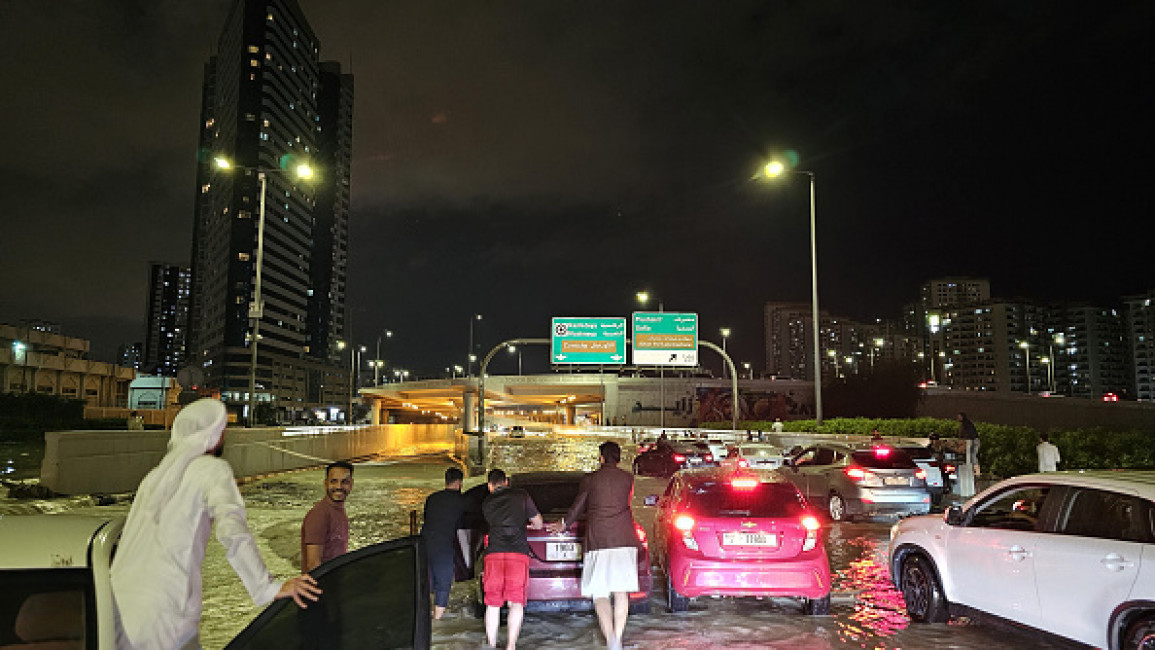One dead in floods as UAE sees heaviest rain in its history
The heaviest rain ever recorded in the UAE's history has killed at least one person and flooded Dubai's highways, homes, and international airport.
The UAE witnessed a record downpour with 254 mm falling in Al-Ain, in the emirate of Abu Dhabi, on Tuesday in less than 24 hours, according to the National Meteorology Centre (NMC), the most rain since records began in 1949 before the country was established in 1971.
In neighbouring Oman, at least 19 people were killed in heavy rains in recent days, according to a statement on Tuesday from the country's National Committee for Emergency Management.
That included 10 schoolchildren swept away in a vehicle, which saw condolences pour into the country from rulers including Saudi Arabia's King Salman and Crown Prince Mohammed bin Salman.
Rain also fell in Bahrain, Qatar and Saudi Arabia but weather conditions were more severe in the UAE and Oman where roads and neighbourhoods were submerged, bringing daily life to a halt.
One of the reasons cited in local media reports included "cloud seeding" - a weather modification technique used by authorities to induce rain during drought.
The UAE, which heavily relies on energy-hungry desalination plants to provide water, conducts cloud seeding in part to increase its dwindling, limited groundwater.
Several local media reports quoted meteorologists at the NCM as saying they flew six or seven cloud-seeding flights before the rain began.
According to news agency The Associated Press, they found that one aircraft affiliated with the UAE’s cloud-seeding efforts flew around the country Sunday.
The NCM later confirmed to Grazia Middle East that cloud seeding operations took place within the last 24 hours and that residents will see a drop in temperatures.
The New Arab reached out to the NCM for comment but did not receive a response by the time of publication.
The rains began late on Monday, soaking the sands and roadways of Dubai with some 20 millimetres (0.79 inches) of rain, according to meteorological data collected at Dubai International Airport.
The storms intensified around 9 a.m. local time on Tuesday and continued throughout the day, dumping more rain and hail onto the overwhelmed city, which is often unable to handle heavy downpours.
By the end of Tuesday, more than 142 millimetres (5.59 inches) of rainfall had soaked Dubai over 24 hours.
An average year sees 94.7 millimetres (3.73 inches) of rain at Dubai International Airport, a hub for the long-haul carrier Emirates.
One of the world's busiest airports, Dubai International, said it had faced significant disruptions after the heavy rains delayed or diverted flights and impacted flight crews.
Passengers departing from Dubai were advised against heading to the airport and to check their flight status with their airline.
"We are working hard to recover operations as quickly as possible in very challenging conditions," the airport wrote on X.
Dubai's national carrier, Emirates, said passengers who were already in transit would continue to be processed but warned that delays to departures and arrivals should be expected. The Dubai airport website showed hours-long delays for some arrival and departure flights.
Local media reported that an elderly Emirati man in his 70s died on Tuesday morning when his vehicle was caught in flash floods in the emirate of Ras Al-Khaimah, in the country's north.
UAE media and social media posts showed significant damage from the torrential downpours in some parts of the country, including collapsed roads and homes inundated by water.
Social media posts on Tuesday showed flooded roads and car parks with some vehicles completely submerged. Sheikh Zayed Road, a 12-lane highway through Dubai, was partially flooded, leaving people stuck in a kilometres-long traffic jam for hours.
Fujairah, an emirate on the UAE's eastern coast, saw the heaviest rainfall Tuesday with 145 millimetres (5.7 inches) falling there.
Authorities cancelled school and the government instituted remote work again for Wednesday.
Rain is unusual in the UAE, an arid, Arabian Peninsula nation, but occurs periodically during the cooler winter months.
Many roads and other areas lack drainage given the lack of regular rainfall, resulting in flooding.


![President Pezeshkian has denounced Israel's attacks on Lebanon [Getty]](/sites/default/files/styles/image_684x385/public/2173482924.jpeg?h=a5f2f23a&itok=q3evVtko)



 Follow the Middle East's top stories in English at The New Arab on Google News
Follow the Middle East's top stories in English at The New Arab on Google News


